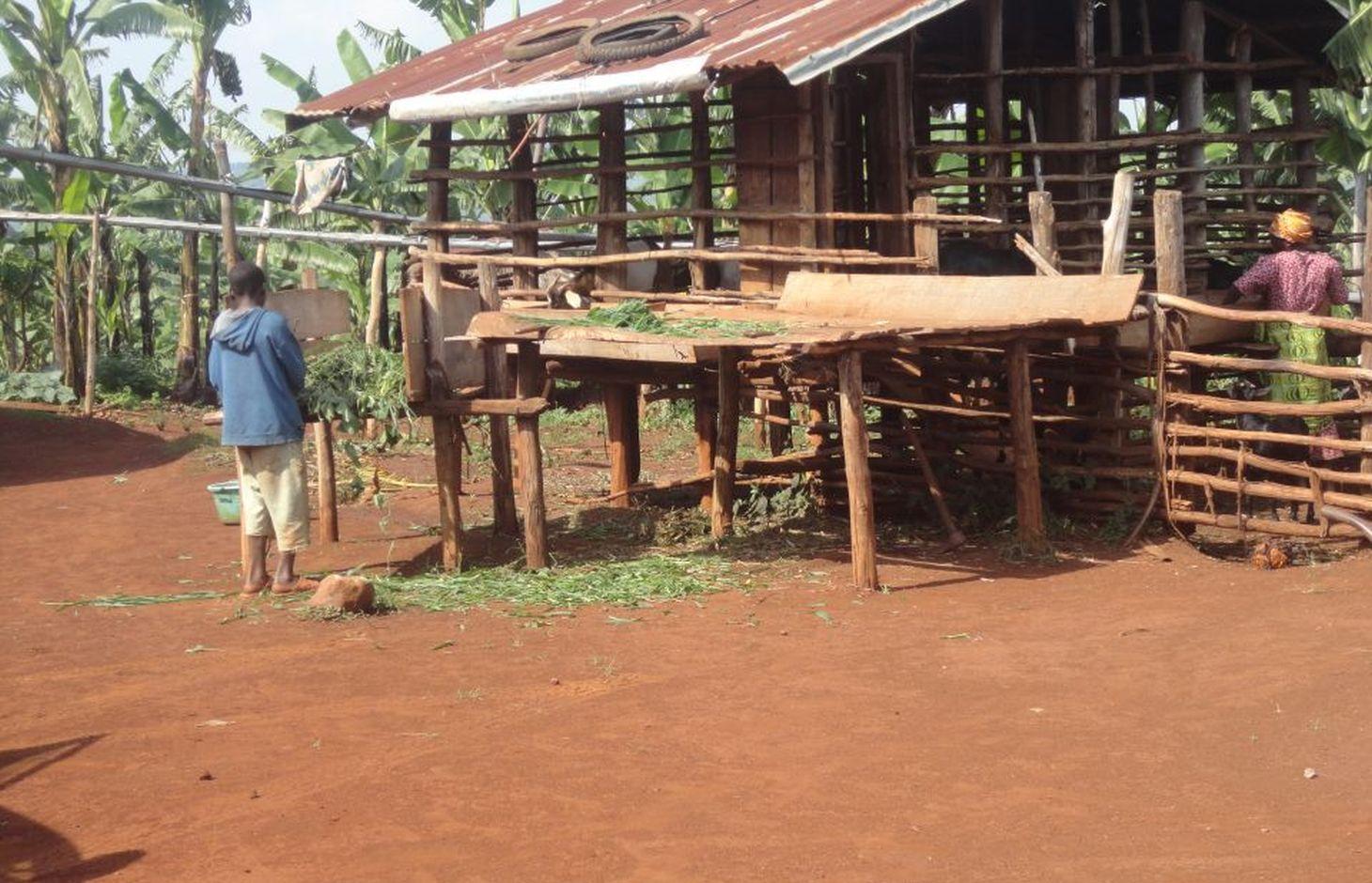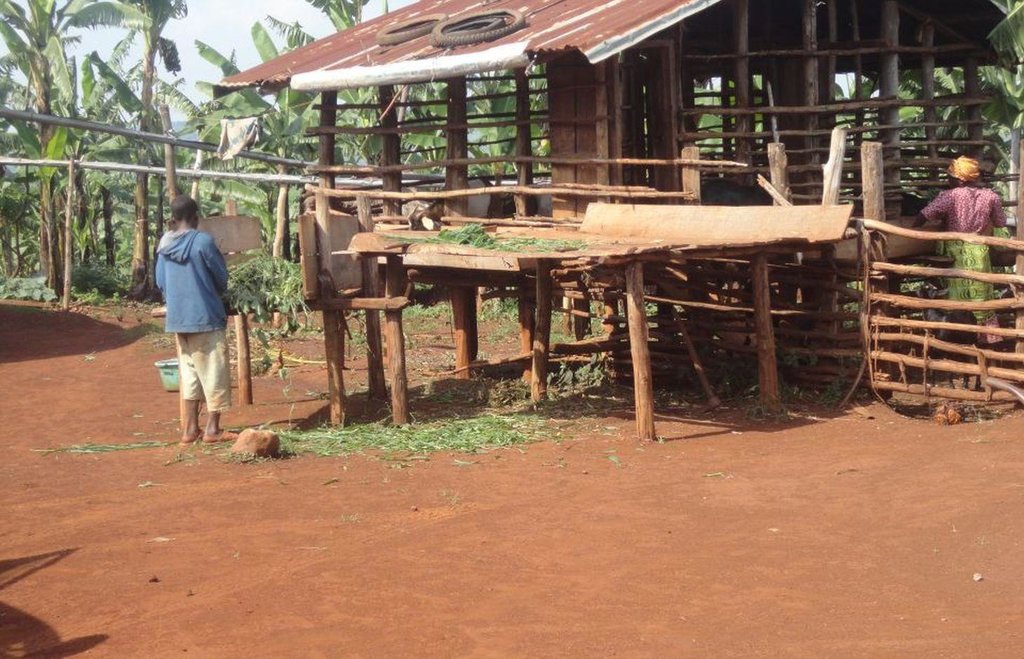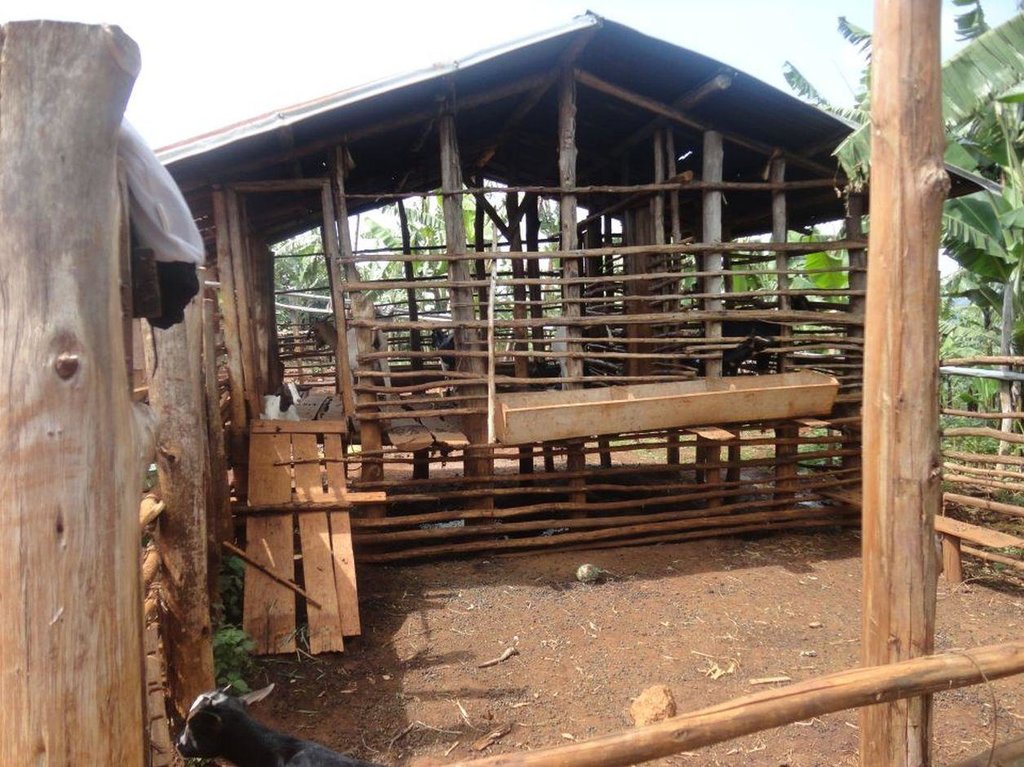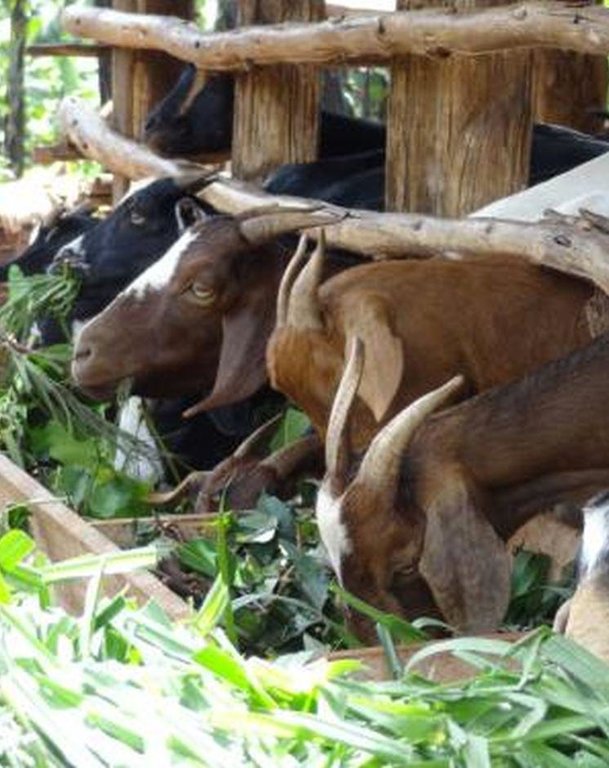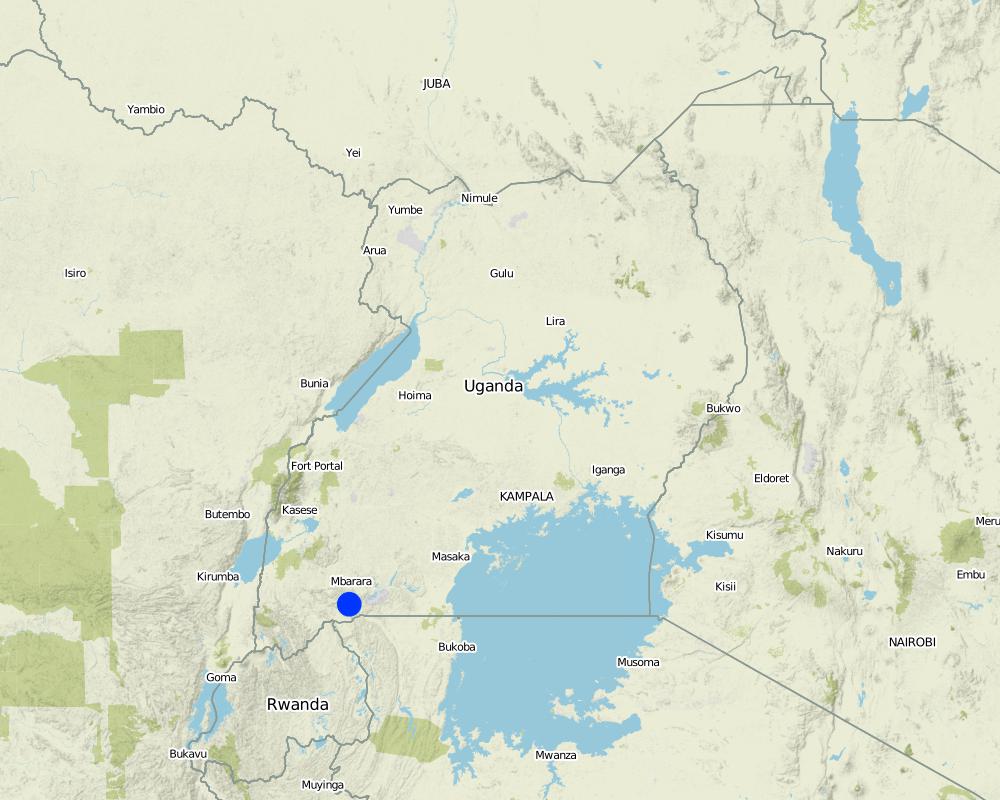Zero grazing [អ៊ូហ្គង់ដា]
- ការបង្កើត៖
- បច្ចុប្បន្នភាព
- អ្នកចងក្រង៖ Wilson Bamwerinde
- អ្នកកែសម្រួល៖ –
- អ្នកត្រួតពិនិត្យច្រើនទៀត៖ Fabian Ottiger, Alexandra Gavilano
Okurisiza hamwe
technologies_1188 - អ៊ូហ្គង់ដា
ពិនិត្យមើលគ្រប់ផ្នែក
ពង្រីកមើលទាំងអស់ បង្រួមទាំងអស់1. ព័ត៌មានទូទៅ
1.2 ព័ត៌មានលម្អិតពីបុគ្គលសំខាន់ៗ និងស្ថាប័នដែលចូលរួមក្នុងការវាយតម្លៃ និងចងក្រងឯកសារនៃបច្ចេកទេស
អ្នកជំនាញឯកទេស SLM:
អ្នកជំនាញឯកទេស SLM:
អ្នកជំនាញឯកទេស SLM:
ឈ្មោះគម្រោងដែលបានចងក្រងឯកសារ/ វាយតម្លៃលើបច្ចេកទេស (បើទាក់ទង)
The Transboundary Agro-ecosystem Management Project for the Kagera River Basin (GEF-FAO / Kagera TAMP )ឈ្មោះអង្គភាពមួយ (ច្រើន) ដែលបានចងក្រងឯកសារ/ វាយតម្លៃបច្ចេកទេស (បើទាក់ទង)
Food and Agriculture Organization (FAO) - ប្រទេសអ៊ីតាលីឈ្មោះអង្គភាពមួយ (ច្រើន) ដែលបានចងក្រងឯកសារ/ វាយតម្លៃបច្ចេកទេស (បើទាក់ទង)
Ministry of Agriculture, Animal Industry, and Fisheries of Uganda (MAAIF) - អ៊ូហ្គង់ដា1.3 លក្ខខណ្ឌទាក់ទងទៅនឹងការប្រើប្រាស់ទិន្នន័យដែលបានចងក្រងតាមរយៈ វ៉ូខេត
អ្នកចងក្រង និង(បុគ្គលសំខាន់ៗ)យល់ព្រមទទួលយកនូវលក្ខខណ្ឌនានាទាក់ទងទៅនឹងការប្រើប្រាស់ទិន្នន័យដែលបានចងក្រងតាមរយៈវ៉ូខេត:
បាទ/ចា៎
2. ការពណ៌នាពីបច្ចេកទេស SLM
2.1 ការពណ៌នាដោយសង្ខេបពីបច្ចេកទេស
និយមន័យបច្ចេកទេស:
Stall-fed livestock production is an efficient method to produce organic fertilizers (manure) for the conservation and improvement of soil fertility.
2.2 ការពណ៌នាលម្អិតពីបច្ចេកទេស
ការពណ៌នា:
Zero-grazing has been a common livestock (cattle and pigs) management practice in most areas of south-western Uganda due to reduced communal grazing land. In the predominantly annual cropping system communities, free grazing livestock often damage crops and are a major cause of conflict. On the other hand, farmers observe that crop yields have declined season after season. For example, the bunch of bananas has grown smaller, it has smaller fingers, and many banana stands have no fruit during much of the year. The most important ways through which croplands in Rubagano are degraded include nutrient transfer through harvest and crop residue movement and use; nutrient mining whereby continuous cultivation is done with little or no replenishment; and soil and water runoff on steep slopes. Farmers know that one of the most important ways to reverse declining soil fertility is to apply manure, but it is expensive. Therefore farmers acquired goats or pigs primarily for the provision of manure for their cropland, but also as a household income generating enterprise. In stall-fed goat or pig production, The zero-grazing unit is designed in such a way that it is well ventilated and protected from wind, rain and constant direct sunshine to avoid livestock developing coughs, colds and stress. The unit has 3 major parts: the feeding and rest area, the exercise area and the manure collection area. The feeding/rest area is raised 1 m above the ground. Below it is the manure collection area and above it, a corrugated iron roof. There is a feeding vat on each side of the feeding/rest area in which mixed fodder is fed to the livestock. A wooden food preparation slab for cutting and mixing fodder is in front of the feeding/rest area. The unit for housing 12 goats is 4 m by 8 m on the ground and 3 m high at the feeding area.
Purpose of the Technology: The major objective of stall-feeding is to maximize manure collection for sustaining soil fertility in cropland. Other goals are to improve household income, reduce expenditure on pests and disease management through livestock isolation from other animals and to reduce labor by cutting and storing fodder for use over a period instead of grazing in distant pastures daily.
Establishment / maintenance activities and inputs: The materials required for establishment of the zero-grazing unit for goats are wooden posts or poles, cut-off planks, wooden slats/timber, iron sheets and nails. The 4 m by 4 m feeding/rest area is raised 1 m above the ground on strong Eucalyptus or pine posts of diameter 5-10 cm. Its wall is 2 m high and is made of widely spaced cut-off planks or light wooden poles not more than 3 cm diameter nailed to strong upright posts. The floor is made of wooden slats placed 2 cm apart, big enough to allow livestock droppings to fall through but too small for adult goats’ or kids’ hooves pass, in order to avoid injury to livestock. There is a 1.5 m by 0.5 m feeding vat on each side of the feeding/rest area and a 1 m by 1 m fodder mixing wooden slab at the front. On the ground to one side of the feeding/rest area is the 4m by 4m exercise area. The unit can be constructed at any time of the year.
Natural / human environment: Regular maintenance of the unit is done to ensure the floor does not develop holes that can lead to injury of the livestock, and the roof does not leak when it rains. Increased manure collection and application increases crop yields and supports crop diversification.
2.3 រូបភាពនៃបច្ចេកទេស
2.5 ប្រទេស/តំបន់/ទីតាំងកន្លែង ដែលបច្ចេកទេសត្រូវបានអនុវត្ត និងបានគ្រប់ដណ្តប់ដោយការវាយតម្លៃនេះ
ប្រទេស:
អ៊ូហ្គង់ដា
តំបន់/រដ្ឋ/ខេត្ត:
Uganda
បញ្ជាក់បន្ថែមពីលក្ខណៈនៃទីតាំង:
Mbarara District
មតិយោបល់:
Boundary points of the Technology area: -0.86313 30.62564; -0.86314 30.62561; -0.86316 30.62569; -0.86319 30.62567
Total area covered by the SLM Technology is 0.002 km2.
There are 20 zero grazing units (goats and pigs) in the area and with a total area of about 2 hectares. The technology is being adopted slowly throughout the community.
Map
×2.6 កាលបរិច្ឆេទនៃការអនុវត្ត
ប្រសិនបើមិនច្បាស់ឆ្នាំ សូមបញ្ជាក់កាលបរិច្ឆេទដែលប្រហាក់ប្រហែល:
- តិចជាង 10ឆ្នាំមុន (ថ្មី)
2.7 ការណែនាំពីបច្ចេកទេស
សូមបញ្ជាក់តើបច្ចេកទេសត្រូវបានណែនាំឱ្យអនុវត្តដោយរបៀបណា:
- តាមរយៈគម្រោង / អន្តរាគមន៍ពីខាងក្រៅ
មតិយោបល់ (ប្រភេទនៃគម្រោង ។ល។):
This technology was introduced in 2008 by NAADS and later by Africa2000 with aim to improve manure and compost production in Kagera region. Recently, Kagera TAMP project provided additional support to introduce exotic breeds of the goats and increase livestock productivity.
3. ចំណាត់ថ្នាក់នៃបច្ចេកទេស SLM
3.1 គោលបំណងចម្បង (១ ឬច្រើន) នៃបច្ចេកទេសនេះ
- កាត់បន្ថយ, បង្ការ, ស្តារឡើងវិញនូវការធ្លាក់ចុះគុណភាពដី
- អភិរក្សប្រព័ន្ធអេកូឡូស៊ី
3.2 ប្រភេទដីប្រើប្រាស់មួយប្រភេទ (ច្រើនប្រភេទ) ដែលបានអនុវត្តបច្ចេកទេស

ដីដាំដំណាំ
- ដំណាំប្រចាំឆ្នាំ
- ដំណាំរយៈពេលវែង (មិនមែនឈើ)
ដំណាំប្រចាំឆ្នាំ - បញ្ជាក់ប្រភេទដំណាំ:
- ពពួកសណ្តែក - សណ្តែកបារាំង
- ឬស/ដំណាំមើម - ដំឡូងបារាំង
ដំណាំរយៈពេលវែង (មិនមែនឈើ) - បញ្ជាក់ប្រភេទដំណាំ:
- ចេក/plantain/abaca
ចំនួនសារដែលដាំដំណាំក្នុងមួយឆ្នាំ:
- 2
សូមបញ្ជាក់:
Longest growing period in days: 120 Longest growing period from month to month: February to May Second longest growing period in days: 90 Second longest growing period from month to month: September to November

ដីសម្រាប់ចិញ្ចឹមសត្វ
ដីវាលស្មៅតូចៗ/ ផលិតកម្មចំណី:
- កាត់ និងជញ្ជូន/ គ្មានវាលស្មៅសម្រាប់ចិញ្ចឹមសត្វ
ប្រភេទសត្វ:
- សត្វពាហនៈ - សត្វចិញ្ចឹមយកទឹកដោះ
- សត្វពពែ
- pigs
មតិយោបល់:
Major land use problems (compiler’s opinion): Reduction of soil organic matter content
Major land use problems (land users’ perception): Decline of soil fertility and decreased crop yields
Cut-and-carry/ zero grazing: Yes
Future (final) land use (after implementation of SLM Technology): Grazing land: Gi: Intensive grazing/ fodder production
Type of cropping system and major crops comments: other crops like peas, millet, maize and sorghum are also grown.
Livestock is grazing on crop residues
3.3 បន្ទាប់ពីអនុវត្តបច្ចេកទេស តើដីប្រើប្រាស់មានការប្រែប្រួលដែររឺទេ?
ដីប្រើប្រាស់ចម្រុះនៅលើដីតែមួយ:
បាទ/ចា៎
បញ្ជាក់ពីប្រភេទដីច្រើនប្រភេទ (ដីដាំដំណាំ/ដីចិញ្ចឹមសត្វ/ដីព្រៃឈើ):
- Agro-pastoralism ( រួមបញ្ចូលទាំងដំណាំ និងចិញ្ចឹមសត្វ)

ដីសម្រាប់ចិញ្ចឹមសត្វ
មតិយោបល់:
Extensive grazing land
3.4 ការផ្គត់ផ្គង់ទឹក
ការផ្គត់ផ្គង់ទឹកនៅកន្លែងអនុវត្តបច្ចេកទេស:
- ទឹកភ្លៀង
3.5 ក្រុម SLM ដែលបច្ចេកទេសស្ថិតនៅក្នុង
- កសិរុក្ខកម្ម (pastoralism) និងការគ្រប់គ្រងដីសម្រាប់ចិញ្ចឹមសត្វ
- ការគ្រប់គ្រងដោយរួមបញ្ចូលការដាំដំណាំ និងការចិញ្ចឹមសត្វ
3.6 វិធានការ SLM ដែលបញ្ចូលនូវបច្ចេកទេស

វិធានការក្សេត្រសាស្ត្រ
- A2: សារធាតុសរីរាង្គ/ជីជាតិដី

វិធានការរុក្ខជាតិ
- V2: ស្មៅនិងរុក្ខជាតិៗដែលដុះមានអាយុមិនលើសពី 2ឆ្នាំ

វិធានការគ្រប់គ្រង
- M2: ការផ្លាស់ប្តូរការគ្រប់គ្រង/ កម្រិតអាំងតង់ស៊ីតេ
មតិយោបល់:
Main measures: agronomic measures, vegetative measures, management measures
Type of agronomic measures: manure / compost / residues
Type of vegetative measures: aligned: -linear
3.7 កំណត់ប្រភេទនៃការធ្លាក់ចុះគុណភាពដីសំខាន់ៗដែលបច្ចេកទេសនេះបានដោះស្រាយ

ការធ្លាក់ចុះសារធាតុគីមីក្នុងដី
- Cn: ការថយចុះជីជាតិ និងកាត់បន្ថយបរិមាណសារធាតុសរីរាង្គ (មិនកើតឡើងដោយការហូរច្រោះទេ)

ការធ្លាក់ចុះជីវសាស្ត្រនៃដី
- Bc: ការថយចុះនូវគម្របរុក្ខជាតិ
មតិយោបល់:
Main type of degradation addressed: Cn: fertility decline and reduced organic matter content, Bc: reduction of vegetation cover
Main causes of degradation: soil management (Poor methods of cultivation), crop management (annual, perennial, tree/shrub) (Poor agronomic practices), over-exploitation of vegetation for domestic use (Vegetation destroyed for domestic use (firewood and thatch).)
Secondary causes of degradation: education, access to knowledge and support services
3.8 ការពារ កាត់បន្ថយ ឬស្តារឡើងវិញនៃការធ្លាក់ចុះគុណភាពដី
បញ្ជាក់ពីគោលដៅរបស់បច្ចេកទេស ដែលផ្តោតទៅការធ្លាក់ចុះគុណភាពដី:
- ការការពារការធ្លាក់ចុះគុណភាពដី
- ការកាត់បន្ថយការធ្លាក់ចុះគុណភាពដី
មតិយោបល់:
Main goals: mitigation / reduction of land degradation
Secondary goals: prevention of land degradation
4. បច្ចេកទេសជាក់លាក់ សកម្មភាពអនុវត្ត ធាតុចូល និងថ្លៃដើម
4.1 គំនូសបច្ចេកទេសនៃបច្ចេកទេសនេះ
លក្ខណៈពិសេសនៃបច្ចេកទេស (ទាក់ទងនឺងគំនូរបច្ចេកទេស):
Details of zero grazing shed structure : A. Overview of the livestock shed with manure colelction area (below) B. View on the feeding arrangement with the fodder vats abouve ground level C. Deatils of the fodder vat D. Overview of the fodder preparation structures
Location: Rubagano, Mwizi, Mbarara District. Uganda
Date: 29-DEC-2013
Technical knowledge required for field staff / advisors: moderate (Comprehensive knowledge on shed construction (e.g. planning, design of shed levels) and livestock management (fodder quality, feeding, diseases))
Technical knowledge required for land users: moderate (Comprehensive knowledge on shed construction (e.g. planning, design of shed levels) and livestock management (fodder quality, feeding, diseases))
Main technical functions: improvement of ground cover, increase in organic matter, increase in nutrient availability (supply, recycling,…)
Secondary technical functions: improvement of surface structure (crusting, sealing), promotion of vegetation species and varieties (quality, eg palatable fodder)
Manure / compost / residues
Material/ species: Manure (Pigs or goats)
Aligned: -linear
Vegetative material: G : grass
Number of plants per (ha): 900
Vertical interval between rows / strips / blocks (m): 3
Spacing between rows / strips / blocks (m): 3
Grass species: Pennisetum purpereum (napier grass), Calliandra Spp.)
Slope (which determines the spacing indicated above): 25-30%
Change of land use type: Mixed crop and livestock husbandry
Change of land use practices / intensity level: Planting fodder in addition to traditional annual and perennial crops
ឈ្មោះអ្នកនិពន្ធ:
Byonabye Proscovia, Kagera TAMP, Kabala
4.2 ព័ត៌មានទូទៅដែលពាក់ព័ន្ធនឹងការគណនាធាតុចូល និងថ្លៃដើម
ផ្សេងៗ/ រូបិយប័ណ្ណជាតិ (បញ្ជាក់):
UGX
បើពាក់ព័ន្ធសូមកំណត់អត្រាប្តូរប្រាក់ពីដុល្លាទៅរូបិយប័ណ្ណតំបន់ (ឧ. 1 ដុល្លារ = 79.9 រៀលនៃរូបិយប័ណ្ណប្រេស៊ីល) ៖ 1 ដុល្លារ =:
2600,0
កំណត់ថ្លៃឈ្នួលជាមធ្យមនៃការជួលកម្លាំងពលកម្មក្នុងមួយថ្ងៃ:
3.85
4.3 សកម្មភាពបង្កើត
| សកម្មភាព | រយៈពេល (រដូវកាល) | |
|---|---|---|
| 1. | Purchase of tools | Wet season |
| 2. | Purchase of construction materials | |
| 3. | Construction of zero grazing shed ( including vats and manura collecion area) | |
| 4. | Purchase of livestock | |
| 5. | Grass seed procurement and sowing | Wet season |
| 6. | Converting part of the cropland (annual and perrenial crops) into fodder production |
4.4 ថ្លៃដើម និងធាតុចូលដែលត្រូវការសម្រាប់ការបង្កើតបច្ចេកទេស
| បញ្ជាក់ពីធាតុចូល | ឯកតា | បរិមាណ | ថ្លៃដើមក្នុងមួយឯកតា | ថ្លៃធាតុចូលសរុប | % នៃថ្លៃដើមដែលចំណាយដោយអ្នកប្រើប្រាស់ដី | |
|---|---|---|---|---|---|---|
| កម្លាំងពលកម្ម | Construction of zero grazing shed ( including vats and manura collecion area) | ha | 1,0 | 115,4 | 115,4 | 100,0 |
| សម្ភារៈ | Tools | Set | 1,0 | 115,4 | 115,4 | 100,0 |
| សម្ភារៈសាងសង់ | Tree poles,nails,sorghum stalk | ha | 1,0 | 38,46 | 38,46 | 100,0 |
| សម្ភារៈសាងសង់ | Corrugated iron sheets | ha | 1,0 | 250,0 | 250,0 | 100,0 |
| ផ្សេងៗ | Livestock (3 Does) | ha | 1,0 | 173,1 | 173,1 | 100,0 |
| ថ្លៃដើមសរុបក្នុងការបង្កើតបច្ចេកទេស | 692,36 | |||||
| ថ្លៃដើមសរុបក្នុងការបង្កើតបច្ចេកទេសគិតជាដុល្លារ | 0,27 | |||||
មតិយោបល់:
Duration of establishment phase: 6 month(s)
Lifespan of:
Tools - 1 year
Construction material - 10 years
Zero grazing shed - 1 year
Livestock - 20 years
4.5 សកម្មភាពថែទាំ
| សកម្មភាព | ពេលវេលា/ ភាពញឹកញាប់ | |
|---|---|---|
| 1. | Cutting and carrying and application of fodder | Daily |
| 2. | Collection, composting and application of manure | Daily |
| 3. | Purchase of tools and materials for reconstruction/repairs of the shed structure | annual |
| 4. | Weeding and gapping | Seasonal |
4.6 កំណត់ថ្លៃដើមសម្រាប់ការថែទាំ/ សកម្មភាពរបស់បច្ចេកទេស (ក្នុងរយៈពេលមួយឆ្នាំ)
| បញ្ជាក់ពីធាតុចូល | ឯកតា | បរិមាណ | ថ្លៃដើមក្នុងមួយឯកតា | ថ្លៃធាតុចូលសរុប | % នៃថ្លៃដើមដែលចំណាយដោយអ្នកប្រើប្រាស់ដី | |
|---|---|---|---|---|---|---|
| កម្លាំងពលកម្ម | Labour | ha | 1,0 | 38,46 | 38,46 | |
| សម្ភារៈ | Tools | ha | 1,0 | 11,54 | 11,54 | 100,0 |
| សម្ភារៈសាងសង់ | Tree poles,nails,sorghum stalk | ha | 1,0 | 3,85 | 3,85 | 100,0 |
| សម្ភារៈសាងសង់ | Corrugated iron sheets | ha | 1,0 | |||
| ផ្សេងៗ | Livestock (3 Does) | ha | 1,0 | 18,0 | 18,0 | 100,0 |
| ថ្លៃដើមសរុបសម្រាប់ការថែទាំដំណាំតាមបច្ចេកទេស | 71,85 | |||||
| ថ្លៃដើមសរុបសម្រាប់ការថែទាំដំណាំតាមបច្ចេកទេសគិតជាដុល្លារ | 0,03 | |||||
មតិយោបល់:
Machinery/ tools: Panga, hoe, tree poles nails, soka jembe, spade, and wheel barrow., Hand hoe, panga.
The costs were calculated for the construction of the shed, acquisition of 3 does and establishment of fodder crops on part of cropland formerly used for annual and perrenial crops. The calculations were done for the technology in August 2011.
4.7 កត្តាសំខាន់បំផុតដែលមានឥទ្ធិពលដល់ការចំណាយ
ពណ៌នាពីកត្តាប៉ះពាល់ចម្បងៗទៅលើថ្លៃដើម:
The most determinate factors in the establishment of the technology are: labour for planting, maintaining and cutting grass and other pastures and carrying the fodder to the zero-grazing unit; labour for fetching water for the animals; and labour for removing and composting manure and spreading into the garden.
5. លក្ខណៈបរិស្ថានធម្មជាតិ និងមនុស្ស
5.1 អាកាសធាតុ
បរិមាណទឹកភ្លៀងប្រចាំឆ្នាំ
- < 250 មម
- 251-500 មម
- 501-750 មម
- 751-1,000 មម
- 1,001-1,500 មម
- 1,501-2,000 មម
- 2,001-3,000 មម
- 3,001-4,000 មម
- > 4,000 មម
កំណត់បរិមាណទឹកភ្លៀង (បើដឹង) ជា មីលីម៉ែត្រ:
1041,00
តំបន់កសិអាកាសធាតុ
- មានភ្លៀងមធ្យម
Thermal climate class: tropics. All months above 18°C.
Rubagano receives at least 6 months of rain in 2 seasons, February to May and September to November
5.2 សណ្ឋានដី
ជម្រាលជាមធ្យម:
- រាបស្មើ (0-2%)
- ជម្រាលតិចតួច (3-5%)
- មធ្យម (6-10%)
- ជម្រាលខ្ពស់បន្តិច (11-15%)
- ទីទួល (16-30%)
- ទីទួលចោត (31-60%)
- ទីទួលចោតខ្លាំង (>60%)
ទម្រង់ដី:
- ខ្ពង់រាប
- កំពូលភ្នំ
- ជម្រាលភ្នំ
- ជម្រាលទួល
- ជម្រាលជើងភ្នំ
- បាតជ្រលងភ្នំ
តំបន់តាមរយៈកម្ពស់ :
- 0-100 ម
- 101-500 ម
- 501-1,000 ម
- 1,001-1,500 ម
- 1,501-2,000 ម
- 2,001-2,500 ម
- 2,501-3,000 ម
- 3,001-4,000 ម
- > 4,000 ម
បញ្ជាក់ថាតើបច្ចេកទេសនេះត្រូវបានអនុវត្តន៍នៅក្នុង:
- សណ្ឋានដីផត
មតិយោបល់ និងបញ្ចាក់បន្ថែមអំពីសណ្ឋានដី :
Altitudinal zone: 1501-2000 m a.s.l. (1740 m.a.s.l)
Slopes on average: Hilly (Fairly steep slopes in places)
5.3 ដី
ជម្រៅដីជាមធ្យម:
- រាក់ខ្លាំង (0-20 សម)
- រាក់ (21-50 សម)
- មធ្យម (51-80 សម)
- ជ្រៅ (81-120 សម)
- ជ្រៅខ្លាំង (> 120 សម)
វាយនភាពដី (ស្រទាប់លើ):
- គ្រើម/ មានពន្លឺ (ខ្សាច់)
សារធាតុសរីរាង្គនៅស្រទាប់ដីខាងលើ:
- មធ្យម (1-3%)
បើអាចសូមភ្ជាប់ការពណ៌នាពីដីឱ្យបានច្បាស់ ឬព័ត៌មានដែលអាចទទួលបាន ឧ. ប្រភេទដី, pH ដី/ ជាតិអាស៊ីត, សមត្ថភាពផ្លាស់ប្តូរកាចុង, វត្តមាននីត្រូសែន, ភាពប្រៃ ។ល។:
Soil depth on average: Shallow (Mother rock easily reached on pitting)
Soil texture: Coarse/light (Sand and stones)
Soil fertility: Low (Fertility depleted; being slowly replenished by application of technology)
Soil drainage/infiltration: Good (Water easily penetrates into the soil)
Soil water storage capacity: Low (Crops easily dry during the dry spell)
5.4 ទឹកដែលអាចទាញមកប្រើប្រាស់បាន និងគុណភាពទឹក
នីវ៉ូទឹកក្រោមដី:
> 50 ម
ទឹកលើដីដែលអាចទាញយកប្រើប្រាស់បាន:
មិនមាន/ គ្មាន
គុណភាពទឹក (មិនបានធ្វើប្រត្តិកម្ម):
ទឹកពិសារដែលគ្មានគុណភាព (តម្រូវឱ្យមានការសំអាត)
មតិយោបល់ និងលក្ខណៈពិសេសផ្សេងៗទៀតលើគុណភាព និងបរិមាណទឹក :
Ground water table: >50m (Not possible to reach water table)
Availability of surface water: Poor/none (No surface water except when it rains)
Water quality (untreated): Poor drinking water (treatement required, muddy water collected by damming runoff in natural rock depressions)
5.5 ជីវៈចម្រុះ
ភាពសម្បូរបែបនៃប្រភេទ:
- ទាប
មតិយោបល់ និងលក្ខណៈពិសេសផ្សេងទៀតលើជីវចម្រុះ:
Low, noticed improvements after application of the technology
5.6 លក្ខណៈនៃអ្នកប្រើប្រាស់ដីដែលអនុវត្តបច្ចេកទេស
ទីផ្សារនៃប្រព័ន្ធផលិតកម្ម:
- ពាក់កណ្តាលពាណិជ្ជកម្ម (ផ្គត់ផ្គង់ខ្លួនឯង/ ពាណិជ្ជកម្ម)
ចំណូលក្រៅកសិកម្ម:
- 10-50% នៃចំណូល
កម្រិតជីវភាព:
- មធ្យម
ឯកជន ឬក្រុម:
- ធ្វើខ្លួនឯង/ គ្រួសារ
កម្រិតប្រើប្រាស់គ្រឿងយន្ត:
- ប្រើកម្លាំងពលកម្ម
យេនឌ័រ:
- ស្ត្រី
- បុរស
សូមបញ្ជាក់ពីលក្ខណៈពាក់ព័ន្ធផ្សេងទៀតអំពីអ្នកប្រើប្រាស់ដី:
Land users applying the Technology are mainly common / average land users
Difference in the involvement of women and men: No difference in involvement of men and women.
Population density: 100-200 persons/km2
Annual population growth: 2% - 3%
14% of the land users are rich and own 37% of the land.
48% of the land users are average wealthy and own 42% of the land.
21% of the land users are poor and own 14% of the land.
17% of the land users are poor and own 7% of the land.
Off-farm income specification: There is increased yield where the technology has been applied, increasing the income generated on-site thereby reducing off-farm percentage.
Level of mechanization: Manual work (use hand hoes)
Market orientation: Mixed (Some crops are sold to generate household income. Goats will be mainly for sale)
5.7 ទំហំផ្ទៃដីជាមធ្យមនៃដីប្រើប្រាស់ដោយអ្នកប្រើប្រាស់ដី ក្នុងការអនុវត្តបច្ចេកទេស
- < 0.5 ហិកតា
- 0.5-1 ហិកតា
- 1-2 ហិកតា
- 2-5 ហិកតា
- 5-15 ហិកតា
- 15-50 ហិកតា
- 50-100 ហិកតា
- 100-500 ហិកតា
- 500-1,000 ហិកតា
- 1,000-10,000 ហិកតា
- > 10,000 ហិកតា
តើផ្ទៃដីនេះចាត់ទុកជាទំហំកម្រិតណាដែរ ខ្នាតតូច មធ្យម ឬខ្នាតធំ (ធៀបនឹងបរិបទតំបន់)?
- ខ្នាតតូច
មតិយោបល់:
Some households have more while others have less land.
5.8 ភាពជាម្ចាស់ដី កម្មសិទ្ធប្រើប្រាស់ដី និងកម្មសិទ្ធប្រើប្រាស់ទឹក
ភាពជាម្ចាស់ដី:
- ឯកជន មិនមានកម្មសិទ្ធ
កម្មសិទ្ធិប្រើប្រាស់ដី:
- ឯកជន
កម្មសិទ្ធប្រើប្រាស់ទឹក:
- អាស្រ័យផលសេរី (មិនមានការកំណត់)
- ឯកជន
មតិយោបល់:
Individual land ownership. Recent introduction of the water harvesting measures provided land owners with access to own water sources
5.9 ការប្រើប្រាស់សេវាកម្ម និងហេដ្ឋារចនាសម្ព័ន្ធ
សុខភាព:
- មិនល្អ
- មធ្យម
- ល្អ
ការអប់រំ:
- មិនល្អ
- មធ្យម
- ល្អ
ជំនួយបច្ចេកទេស:
- មិនល្អ
- មធ្យម
- ល្អ
ការងារ (ឧ. ការងារក្រៅកសិដ្ឋាន):
- មិនល្អ
- មធ្យម
- ល្អ
ទីផ្សារ:
- មិនល្អ
- មធ្យម
- ល្អ
ថាមពល:
- មិនល្អ
- មធ្យម
- ល្អ
ផ្លូវ និងការដឹកជញ្ជូន:
- មិនល្អ
- មធ្យម
- ល្អ
ទឹកផឹក និងអនាម័យ:
- មិនល្អ
- មធ្យម
- ល្អ
សេវាកម្មហិរញ្ញវត្ថុ:
- មិនល្អ
- មធ្យម
- ល្អ
6. ផលប៉ះពាល់ និងការសន្និដ្ឋាន
6.1 ផលប៉ះពាល់ក្នុងបរិវេណអនុវត្តបច្ចេកទេសដែលកើតមាន
ផលប៉ះពាល់លើសេដ្ឋកិច្ចសង្គម
ផលិតផល
ផលិតកម្មដំណាំ
គុណភាពមុន SLM:
10kg
គុណភាពក្រោយ SLM:
60kg
មតិយោបល់/ ការបញ្ជាក់:
increased yields for beans realised.
ផលិតកម្មចំណីសត្វ
គុណភាពចំណីសត្វ
ផលិតកម្មសត្វ
ហានិភ័យនៃភាពបរាជ័យរបស់ផលិតកម្ម
ភាពសម្បូរបែបនៃផលិតផល
ផ្ទៃដីផលិតកម្ម
ចំណូល និងថ្លៃដើម
ចំណូលក្នុងកសិដ្ឋាន
គុណភាពមុន SLM:
23dollars per yr
គុណភាពក្រោយ SLM:
92 dollars per yr.
មតិយោបល់/ ការបញ្ជាក់:
yields increased from sell of goats
ភាពសម្បូរបែបប្រភពប្រាក់ចំណូល
បន្ទុកការងារ
មតិយោបល់/ ការបញ្ជាក់:
As there is now a lot more activity on-farm
ផលប៉ះពាល់ទៅលើវប្បធម៌សង្គម
សន្តិសុខស្បៀង/ ភាពគ្រប់គ្រាន់ខ្លួនឯង
ស្ថាប័នសហគមន៍
ស្ថាប័នជាតិ
ចំណេះដឹង SLM / ការធ្លាក់ចុះគុណភាពដី
មតិយោបល់/ ការបញ្ជាក់:
Vegetation cover has been improved.
Improved livelihoods and human well-being
មតិយោបល់/ ការបញ្ជាក់:
Food security and household income have improved. This has resulted in children in these households having more time for school and in case of illness, there in some money for accessing treatment.
ផលប៉ះពាល់ទៅលើអេកូឡូស៊ី
ដី
គម្របដី
វដ្តនៃសារធាតុចិញ្ចឹម/ការទទួលបាន
សារធាតុសរីរាង្គដី/ការបូនក្រោមដី
ជីវចម្រុះ៖ ដំណាំ, សត្វ
ជីវម៉ាស/ កាបូនលើដី
ភាពសម្បូរបែបនៃទីជំរក
6.2 ផលប៉ះពាល់ក្រៅបរិវេណអនុវត្តបច្ចេកទេសដែលកើតមាន
ខូចខាតដល់ស្រែអ្នកជិតខាង
មតិយោបល់/ ការបញ្ជាក់:
livestock is confined
6.3 ភាពប្រឈម និងភាពរួសនៃបច្ចេកទេសទៅនឹងការប្រែប្រួលអាកាសធាតុ និងគ្រោះអាកាសធាតុ/ គ្រោះមហន្តរាយ (ដែលដឹងដោយអ្នកប្រើប្រាស់ដី)
ការប្រែប្រួលអាកាសធាតុ
ការប្រែប្រួលអាកាសធាតុ
| រដូវកាល | កើនឡើង ឬថយចុះ | លក្ខណៈឆ្លើយតបនៃបច្ចេកទេសទៅនឹងការប្រែប្រួលអាកាសធាតុ | |
|---|---|---|---|
| សីតុណ្ហភាពប្រចាំឆ្នាំ | កើនឡើង | ល្អ |
គ្រោះអាកាសធាតុ (មហន្តរាយ)
គ្រោះមហន្តរាយធម្មជាតិ
| លក្ខណៈឆ្លើយតបនៃបច្ចេកទេសទៅនឹងការប្រែប្រួលអាកាសធាតុ | |
|---|---|
| ព្យុះភ្លៀងតាមតំបន់ | ល្អ |
គ្រោះមហន្តរាយអាកាសធាតុ
| លក្ខណៈឆ្លើយតបនៃបច្ចេកទេសទៅនឹងការប្រែប្រួលអាកាសធាតុ | |
|---|---|
| រាំងស្ងួត | ល្អ |
មតិយោបល់:
Forage and fodder usually become scorched during seasons of long drought and livestock may die from lack of food. Grass is cut in the wet season while it is plentiful and turned into hay for the time of scarcity. For this, a barn unit needs to be constructed.
6.4 ការវិភាគថ្លៃដើម និងអត្ថប្រយោជន៍
តើផលចំណេញ និងថ្លៃដើមត្រូវបានប្រៀបធៀបគ្នាយ៉ាងដូចម្តេច (ទស្សនៈរបស់អ្នកប្រើប្រាស់ដី)?
រយៈពេលខ្លី:
អវិជ្ជមាន
រយៈពេលវែង:
វិជ្ជមានខ្លាំង
តើផលចំណេញ និងការថែទាំ/ ជួសជុលត្រូវបានប្រៀបធៀបគ្នាយ៉ាងដូចម្តេច (ទស្សនៈរបស់អ្នកប្រើប្រាស់ដី)?
រយៈពេលខ្លី:
វិជ្ជមាន
រយៈពេលវែង:
វិជ្ជមានខ្លាំង
មតិយោបល់:
The benefits far outweigh the establishment and maintenance costs. The negative on short-term returns is due to the cost of the technology (construction and procuring livestock) which is a little high for the farmers in this area.
6.5 ការទទួលយកបច្ចេកទេស
បើអាច សូមបញ្ជាក់ពីបរិមាណ (ចំនួនគ្រួសារ និង/ ឬតំបន់គ្របដណ្តប់):
20 on 2 hectares
ក្នុងចំណោមគ្រួសារទាំងអស់ដែលបានអនុវត្តបច្ចេកទេស តើមានប៉ុន្មានគ្រួសារដែលចង់ធ្វើដោយខ្លួនឯង ដោយមិនទទួលបានសម្ភារៈលើកទឹកចិត្ត/ប្រាក់ឧបត្ថម្ភ?:
- 11-50%
មតិយោបល់:
90% of land user families have adopted the Technology with external material support
18 land user families have adopted the Technology with external material support
Comments on acceptance with external material support: The does were supplied to farmers using project funds.
10% of land user families have adopted the Technology without any external material support
2 land user families have adopted the Technology without any external material support
Comments on spontaneous adoption: these farmers are rich and procured the technology without support from the project
There is a moderate trend towards spontaneous adoption of the Technology
Comments on adoption trend: 20 households in one village have adopted the technology
6.7 ភាពខ្លាំង/ គុណសម្បត្តិ/ ឱកាសនៃបច្ចេកទេស
| ភាពខ្លាំង/ គុណសម្បត្តិ/ ឱកាសនៅកន្លែងរបស់អ្នកប្រើប្រាស់ដី |
|---|
|
Technology easy to establish and maintain How can they be sustained / enhanced? Proper management of the livestock |
|
Helps in soil fertility management How can they be sustained / enhanced? Good manure management |
|
Imporove soil cover and reduce soil erosion How can they be sustained / enhanced? using the manure in a proper /recommended way i.e. using it when planting or putting it in the plot before primary cultivation |
| ភាពខ្លាំង/ គុណសម្បត្តិ/ ឱកាស ទស្សនៈរបស់បុគ្គលសំខាន់ៗ |
|---|
|
Animals are fed on selected pasture How can they be sustained / enhanced? Promote the growing of that pasture |
|
The technology promotes us of organic manure How can they be sustained / enhanced? Use of compost pits to recycle the wastes into manure |
6.8 ភាពខ្សោយ/ គុណវិបត្តិ/ ហានិភ័យនៃបច្ចេកទេស និងវិធីសាស្ត្រដោះស្រាយ
| ភាពខ្សោយ/ គុណវិបត្តិ/ ហានិភ័យ ទស្សនៈរបស់អ្នកចងក្រងឬបុគ្គលសំខាន់ៗ | តើបច្ចេកទេសទាំងនោះបានដោះស្រាយបញ្ហាដូចម្តេច? |
|---|---|
| The technology may contribute to loss of vegetation | Planting pasture & other grass for feeding the animals |
7. ឯកសារយោង និងវេបសាយ
7.2 ឯកសារយោងដែលបានចេញផ្សាយ
ចំណងជើង អ្នកនិពន្ធ ឆ្នាំ ISBN:
Kagera TAMP project website
មានប្រភពមកពីណា? ថ្លៃដើមប៉ុន្មាន?
http://www.fao.org/nr/kagera/en/
ការតភ្ជាប់ និងម៉ូឌុល
ពង្រីកមើលទាំងអស់ បង្រួមទាំងអស់ការតភ្ជាប់
គ្មានការតភ្ជាប់
ម៉ូឌុល
គ្មានម៉ូឌុល


